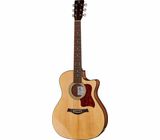For many years my only folk guitar was a Yamaha FG-180 made in Taiwan bought in London 50 years ago. Those FGs are famous for good reason. This one still plays and sounds very nicely. But, I wanted a wider neck instrument to practice some fingerpicking, maybe with a bit of amplification, and that´s how the CLG-48CE stepped in.
The guitar is very well finished, to my eyes at least, it's almost as good looking as the CLJ-412E NT 12-string I also have. The walnut back and sides, although more sustainable ecologically of course, are a bit darker and greyer that the - more luminous - Ovangkol and abalone-gold combination of the 12 string. But that was a minor issue.
Much sadder was the sound of that thing, or specifically, the lack of it. No resonation whatsoever. That was the real bummer. To make things worse, the setup was irritating since the nut was about half a millimeter too high and the bridge saddle also higher than "normal". I reported the problems to Thomann's after-sales, hinting at maybe rusty string cores and poor setup, but they just recommended to see a luthier. Maybe I should havesimply returned the instrument but still went ahead with my not-so-great DiY skills. Sanded the undersides of both nut and saddle, somehow ignoring the recommendations (pick up won't work etc).
In the meantime the guitar was placed on a stand and very slowly it seemed to be gaining some voice, until by the time I bought some new Elixirs locally and put them on the *ROUGHLY* adjusted nut and saddle - it started to sing! Not perfection, but what a difference!
For myself anyway, the conclusion and moral of the story is that - probably the guitar was kept in humidified environment as it should yes, but for too long or too humid conditions. That would explain the visibly rusty strings and mute wood behaviour. And also how after a couple weeks ventilation and string change it normalised to a large extent. And BTW, I never got replacement strings or nuts. Service was obviously too busy and so was I, to vehemently demand it.
Apart from these important issues and considerations, the instrument is quite good for its price range, decent finish, very good intonation (important since not little or no regulation possible) and decent sound, acooustically and amplified.
But I would leave Thomann a suggestion: why not include in these instruments a spare saddle and nut, maybe a hair lower than the main one just to help the buyer solve these all too common issues? It might increase costs a couple of € but it would be well worth it. Or, alternatively, make available the concerned parts on the store.


